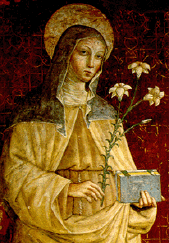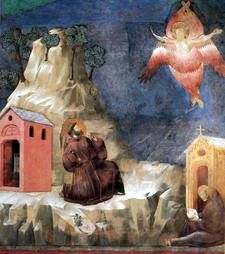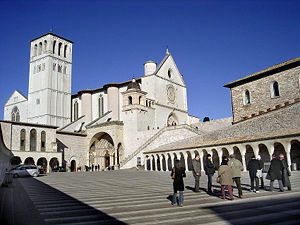- Home - Mass Info - Photos - Biography - Padre
Pio Prayers - Prayer Requests - Websites - Padre
Pio TV - Voice
of
Padre Pio - Friaries - St.
Francis -
- San
Giovanni Rotondo -
Padre Pio was a Capuchin of the order of St. Francis and to help us
understand him
better we need to know something of the Saint who inspired him to
become a Friar

|
Saint Francis of Assisi (Sept 26, 1181 - October 3, 1226) was
a Roman Catholic friar and
the founder of the Order of Friars
Minor, more commonly known as the Franciscans.
He
is known as the patron saint of animals, birds, and the environment,
and it is customary
for Catholic churches to hold ceremonies
honoring animals around his feast day of October 4.
|

Saint Francis in Prayer,
El Greco, 1580–85, oil on canvas, Joslyn Art Museum |
His childhood
and early adulthood
Francis was born to Pietro di Bernardone, a prominent businessman,
and his wife Pica Bourlemont, about whom little is known except
that she was originally from France. He was one of seven children.
Pietro was in France on business when Francis was born, and
Pica had him baptized as Giovanni di Bernardone in honor of
Saint John the Baptist, in the hope he would grow to be a great
religious leader. When his father returned to Assisi, he was
furious about this, as he did not want his son to be a man of
the Church. Pietro decided to call him Francesco (Francis),
in honor of the child's maternal heritage.
Rebellious toward his father's business and pursuit of wealth,
Francis spent most of his youth lost in books (ironically,
his father's wealth did afford his son an excellent education,
and he became fluent in reading several languages including
Latin). He was also known for drinking and enjoying the company
of his many friends, who were usually the sons of nobles.
His displays of disillusionment toward the world that surrounded
him became evident fairly early, one of which is shown in
the story of the beggar. In this account, he found himself
out having fun with his friends one day when a beggar came
along and asked for alms. While his friends ignored the beggar's
cries, Francis gave the man everything he had in his pockets.
His friends quickly chided and mocked him for his act of charity,
and when he got home, his father scolded him in a rage.
In 1201, he joined a military expedition against Perugia,
was taken prisoner at Collestrada, and spent a year as a captive.
It is probable that his conversion to more serious thoughts
was a gradual process relating to this experience. After his
return to Assisi in 1203, Francis recommenced his carefree
life. But in 1204 a serious illness started a spiritual crisis.
In 1205 Francis left for Puglia to enlist in the army of Gualtiero
di Brienne. But on his way, in Spoleto, a strange vision made
him return to Assisi, deepening his spiritual crisis. |
It is said that when he began to avoid the sports
and the feasts of his former companions, and they asked him
laughingly if he was thinking of marrying, he answered "yes,
a fairer bride than any of you have ever seen" - meaning
his "lady poverty", as he afterward used to say. He
spent much time in lonely places, asking God for enlightenment.
By degrees he took to nursing lepers, the most repulsive victims
in the lazar houses near Assisi. After a pilgrimage to Rome,
where he begged at the church doors for the poor, he claimed
to have had a mystical experience in the Church of San Damiano
just outside of Assisi, in which the Icon
of Christ Crucified came alive and said to him three times,
"Francis, Francis, go and repair My house which,
as you can see, is falling into ruins." He
thought this to mean the very ruined church in which he was
presently praying, and so sold his horse together with some
cloth from his father's store, to assist the priest there for
this purpose. |
 Francis of Assisi
Francis of Assisi
by José de Ribera |
His father Pietro, highly indignant, attempted to bring him
to his senses, first with threats and then with corporal chastisement.
After a final interview in the presence of the bishop, Francis
renounced his father and his patrimony, laying aside even the
garments he had received from him. For the next couple of months
he lived as a beggar in the region of Assisi. Returning to the
town for two years this time, he restored several ruined churches,
among them the Porziuncola, little chapel of St Mary of the
Angels, just outside the town, which later became his favorite
abode. |
The founding of the Order of Friars
Minor
 St. Francis of Assisi
St. Francis of Assisi
in
Sacro
Speco,
Subiaco, Italy |
At the end of this period (according to Jordanus,
on February 24, 1209), Francis heard a sermon that changed
his life. The sermon was about Matthew 10:9, in which Christ
tells his followers that they should go forth and proclaim
that the Kingdom of Heaven was upon them, that they should
take no money with them, nor even a walking stick or shoes
for the road. Francis was inspired to devote himself wholly
to a life of poverty.
Clad in a rough garment, barefoot,
and, after the Evangelical precept, without staff or scrip,
he began to preach repentance. He was soon joined by his
first follower, a prominent fellow townsman, the jurist
Bernardo di Quintavalle, who contributed all that he had
to the work. Many other companions joined Francis, and reached
the number of eleven within a year. Francis chose never
to be ordained a priest, and the community lived as "fratres
minores", in Latin, "lesser brothers". The
Franciscans are sometimes called Friars Minor, a term derived
from "fratres", in Latin, "brothers".
The brothers lived a simple life in the deserted lazar
house of Rivo Torto near Assisi; but they spent much of
their time wandering through the mountainous districts of
Umbria, always cheerful and full of songs, yet making a
deep impression on their hearers by their earnest exhortations. |
|
In 1209 Francis led his first 11 followers to Rome to
seek permission from Pope Innocent III to found a new religious
order. At first his attempt to speak with the Pope was refused;
but the following night, according to accounts, Innocent
saw in a dream the church was crumbling apart and a poor
man appearing to hold it up. The next morning, recalling
the poor man he had refused the day before, he recognized
him as the man he saw in his dream, and decided to change
his verdict the following day |
His Later life
 From
then on, his new order grew quickly with new vocations. When
hearing Francis preaching in the church of San Rufino in Assisi
in 1209, Clare of Assisi became deeply touched by his message
and she realized her calling. Her brother Rufino also joined
the new order.
On Palm Sunday, 28 March 1211 Francis received Clare at the
Porziuncola and hereby established the Order of Poor Dames,
later called Poor Clares. In the same year, Francis left for
Jerusalem, but he was shipwrecked by a storm on the Dalmatian
coast, forcing him to return to Italy.
On 8 May 1213 he received the mountain of La Verna as a gift
from the count Orlando di Chiusi. This mountain would become
one of his favorite retreats for prayer.
In the same year, Francis sailed for Morocco, but this time
an illness forced him to break off his journey in Spain. Back
in Assisi, several noblemen, among them Tommaso
da Celano, (who would later write the biography of St. Francis)
and some well-educated men joined his order. |
 The Porziuncola
The Porziuncola |
|
In 1215 Francis went again to Rome for the
Fourth Lateran Council. During this time, he probably met
Dominic de Guzman.
In 1216 Francis received from the new pope Honorius III
the confirmation of the indulgence of the Porziuncola, now
better known as the Pardon of Assisi : which the Pope decreed
to be a complete remission of their sins for all those who
prayed in the Porziuncola.
In 1217 the growing congregation of friars was divided
in provinces and groups were sent to France, Germany, Hungary,
Spain and to the East. |
.jpg) St. Francis before the Sultan - the trial
St. Francis before the Sultan - the trial
by fire (fresco attributed to Giotto) |
In 1219 Francis left, together with a few
companions, on a pilgrimage of non-violence to Egypt. Crossing
the lines between the sultan and the Crusaders in Damietta,
he was received by the sultan Melek-el-Kamel.[2] Francis
challenged the Muslim scholars to a test of true religion
by fire; but they retreated. When Francis proposed to enter
the fire first and, if he left the fire unharmed, the sultan
would have to recognize Christ as the true God, the sultan
was so impressed that he allowed him to preach to his subjects.[3]
Though he didn't succeed in converting the sultan, the last
words of the sultan to Francis of Assisi were, according
to Jacques de Vitry, bishop of Acre, in his book "Historia
occidentalis, De Ordine et praedicatione Fratrum Minorum
(1221)" : “Pray for me that God may deign to
reveal to me that law and faith which is most pleasing to
him.”.
At Saint Jean d'Acre, the capital of what remained of the
Kingdom of Jerusalem, he rejoined the brothers Elia and
Pietro Cattini. Francis then most probably visited the holy
places in Palestine in 1220. |
|
Around 1220 St Francis of Assisi celebrated Christmas by
setting up the first presepio or crèche (Nativity)
in the town of Greccio near Assisi. He used real animals
to create a living scene so that the worshipers could contemplate
the birth of the child Jesus in a direct way, making use
of the senses, especially sight.
When receiving a report of the martyrdom of five brothers
in Morocco, he returned to Italy via Venice. Cardinal Ugolino
di Conti was then nominated by the Pope as the protector
of the order. When problems arose in the order, a detailed
rule became necessary. On 29 September 1220 Francis handed
over the governance of the order to brother Pietro Cattini
at the Porziuncola. However, Brother Cattini died on 10
March 1221. He was buried in the Porziuncola. But when numerous
miracles were attributed to the late Pietro Cattini, people
started to flock to the Porziuncola, disturbing the daily
life of the Franciscans. Francis then prayed, asking Pietro
to stop the miracles and obey in death as he had obeyed
him during his life. The report of miracles ceased. Brother
Pietro was succeeded by brother Elia as vicar of Francis. |
During 1221 and 1222 Francis crossed Italy,
first as far south as Catania in Sicily and afterwards as
far north as Bologna.
On 29 November 1223 the final rule of the order (in twelve
chapters) was approved by Pope Honorius III.
While he was praying on the mountain of Verna, during a
forty day fast in preparation for Michaelmas, Francis is
said to have had a vision on or about 14 September 1224,
the Feast of the Exaltation of the Cross, as a result of
which he received the stigmata. Brother Leo, who had been
with Francis at the time, left a clear and simple account
of the event,[5] the first definite account of the phenomenon
of stigmata. "Suddenly he saw a vision of a seraph,
a six-winged angel on a cross. This angel gave him the gift
of the five wounds of Christ."
Suffering from these Stigmata and from an eye disease,
he had been receiving care in several cities (Siena,
Cortona, Nocera) to no avail.
In the end he was brought back to the Porziuncola. |
 St. Francis receives the Stigmata
St. Francis receives the Stigmata
(fresco
attributed to Giotto) |
He was
brought to the transito, the hut for infirm friars, next to
the Porziuncola. Here, in the place where it all began, feeling
the end approaching, he spent the last days of his life dictating
his spiritual testament. He died on the evening of 3 October
1226 singing Psalm 141. His feast day is observed 4 October.
On 16 July 1228 he was pronounced a saint by the next pope
Gregory IX, the former cardinal Ugolino di Conti, friend
and protector of St. Francis. The next day, the pope laid
the foundation stone for the Basilica of Saint Francis in
Assisi.
St. Francis is considered the first Italian poet by literary
critics. He believed commoners should be able to pray to
God in their own language, and he wrote always in dialect
of Umbria instead of Latin. His writings are considered
to have great literary value, as well as religious. |
Saint Francis, nature, and the environment
Many of the stories that surround the life of St Francis
deal with his love for animals. Perhaps the most famous incident
that illustrates the Saint’s humility towards nature
is recounted in the 'Fioretti' (The Little Flowers), a collection
of legends and folk-lore that sprang up after the saint’s
death. It is said that one day while Francis was traveling
with some companions they happened upon a place in the road
where birds filled the trees on either side. Francis told
his companions to “wait for me while I go to preach
to my sisters the birds.” The birds surrounded him,
drawn by the power of his voice, and not one of them flew
away. Francis spoke to them: "My sister birds,
you owe much to God, and you must always and in everyplace
give praise to Him; for He has given you freedom to wing
through the sky and He has clothed you…you neither
sow nor reap, and God feeds you and gives you rivers and
fountains for your thirst, and mountains and valleys for
shelter, and tall trees for your nests. And although you
neither know how to spin or weave, God dresses you and your
children, for the Creator loves you greatly and He blesses
you abundantly. Therefore… always seek to praise God."
|
 A garden statue of Francis of Assisi
A garden statue of Francis of Assisi
with birds |
Another legend from the Fioretti tells us that in the city
of Gubbio, where Francis lived for some time, there was a
wolf “terrifying and ferocious, who devoured men as
well as animals.” Francis had compassion upon the townsfolk,
and went up into the hills to find the wolf. Soon fear of
the animal had caused all his companions to flee, but the
saint pressed on and when he found the wolf he made the sign
of the cross and commanded the wolf to come to him and hurt
no one. Miraculously the wolf closed his jaws and lay down
at the feet of St. Francis. “Brother Wolf, you do much
harm in these parts and you have done great evil…”
said Francis. “All these people accuse you and curse
you…But brother wolf, I would like to make peace between
you and the people.” Then Francis led the wolf into
the town, and surrounded by startled citizens he made a pact
between them and the wolf. Because the wolf had “done
evil out of hunger” the townsfolk were to feed the wolf
regularly, and in return, the wolf would no longer prey upon
them or their flocks. In this manner Gubbio was freed from
the menace of the predator. Francis, ever the lover of animals,
even made a pact on behalf of the town dogs, that they would
not bother the wolf again.
These legends exemplify the Franciscan mode of charity
and poverty as well as the saint's love of the natural world.
Part of his appreciation of the environment is expressed
in his Canticle of the Sun, a poem written in Umbrian Italian
in perhaps 1224 which expresses a love and appreciation
of Brother Sun, Sister Moon, Mother Earth, Brother Fire,
etc. and all of God's creations personified in their fundamental
forms. In "Canticle of the Creatures," he wrote:
"All praise to you, Oh Lord, for all these brother
and sister creatures."[1]
Francis's attitude towards the natural world, while poetically
expressed, was conventionally Christian. He believed that
the world was created good and beautiful by God but suffers
a need for redemption because of the primordial sin of man.
He preached to man and beast the universal ability and duty
of all creatures to praise God (a common theme in the Psalms)
and the duty of men to protect and enjoy nature as both
the stewards of God's creation and as creatures ourselves.
Legend has it that St Francis thanked his donkey at his
bedside for carrying and helping him throughout his life,
and his donkey wept. |
Main sources for the life of Saint
Francis
| * |
Friar Elias, Epistola Encyclica de Transitu
Sancti Francisci, 1226. |
 Basilica of St. Francis in Assisi.
Basilica of St. Francis in Assisi.
|
| * |
Pope Gregory IX, Bulla "Mira circa nos" for the
canonization of St. Francis, 19 July 1228. |
| * |
Friar Tommaso da Celano: Vita Prima Sancti Francisci, 1228;
Vita Secunda Sancti Francisci, 1246 – 1247; Tractatus
de Miraculis Sancti Francisci, 1252 – 1253. |
| * |
Friar Julian of Speyer, Vita Sancti Francisci, 1232 –
1239. |
| * |
St. Bonaventure of Bagnoregio, Legenda Maior Sancti Francisci,
1260 – 1263. |
| * |
Ugolino da Montegiorgio, Actus Beati Francisci et sociorum
eius, 1327 – 1342. |
| * |
Fioretti di San Francesco, the "Little Flowers of St.
Francis", end of the 14th century: an anonymous Italian
version of the Actus; the most popular of the sources, but
very late and therefore not the best authority by any means. |
Main writings by St. Francis
See also
| * |
|
| |
|
| * |
|
| * |
Prayer of Saint Francis,
a prayer attributed to St. Francis of Assisi although there
is no record of it prior to 1912. |
| * |
|
| * |
|
| * |
|
| * |
|
| * |
The Flowers
of St. Francis (1950), a film by Roberto Rossellini.
A strange film, the characters are portrayed as almost comical
in some ways. Also known as "Francis, God's Jester"
after the original Italian title of "Francesco giullare
di Dio" |
| * |
Francis
of Assisi (1961), a film by Michael Curtiz. Very much
a Holywood version but enjoyable none the less. |
| * |
Brother
Sun, Sister Moon (1972), a film by Franco Zeffirelli,
portays Francis almost in the style of a hippy, probably
fashiomable to do so at the time. |
| * |
Francesco
(1990), a film by Liliana Cavani. No comments on this film
as yet. |
| * |
Flowers for St Francis (2005), a book by Raj Arumugam
(see www.ttsworld.com.au) |
| * |
Reluctant Saint: The Life of Francis of Assisi a book
by Donald Spoto (2002) |
| * |
Saint Francis and His Four Ladies (1970) a book by Joan
Mowat Erikson |
| * |
List of people on stamps of Ireland |
| * |
Siena College |
| * |
University of Saint Francis (Illinois), a school founded
in the tradition of St. Francis of Assisi. |
| * |
Saint Francis University (Pennsylvania) |
Adapted
from the Wikipaedia article on St. Francis - please e-mail
me with any inaccuracies you may find.
For more about
the Crucifix of San Damiano click here
|






 From
then on, his new order grew quickly with new vocations. When
hearing Francis preaching in the church of San Rufino in Assisi
in 1209, Clare of Assisi became deeply touched by his message
and she realized her calling. Her brother Rufino also joined
the new order.
From
then on, his new order grew quickly with new vocations. When
hearing Francis preaching in the church of San Rufino in Assisi
in 1209, Clare of Assisi became deeply touched by his message
and she realized her calling. Her brother Rufino also joined
the new order.
.jpg)


